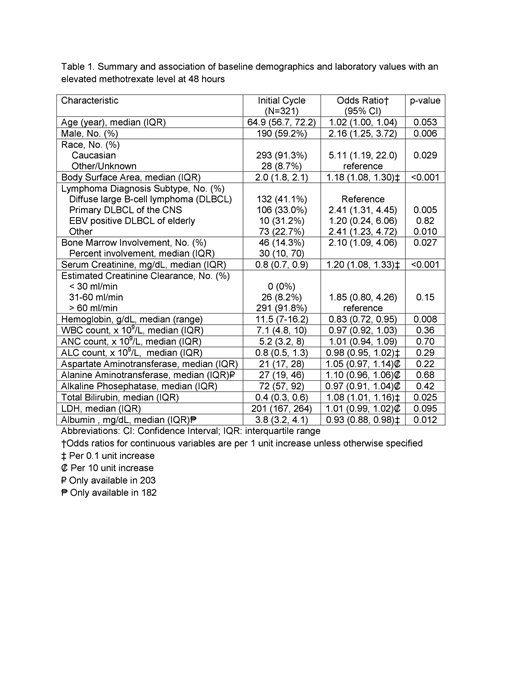Background: Prolonged methotrexate (MTX) exposure following high-dose methotrexate (HDMTX; ≥1g/m2) occurs in up to 33% of patients and potentially compromises management through increased renal and systemic toxicities.(Pinedo et al, 1977, Joerger et al, 2012) MTX-associated acute kidney injury (AKI) occurs in 5% to 30% of patients.(May et al, 2014) Rescue leucovorin dose escalation in response to an elevated 48-hour MTX concentration or serum creatinine rise is standard-of-care to reduce adverse events. The practice of preemptive leucovorin dose increases in patients with elevated MTX concentrations or previous AKI during prior MTX doses has unclear outcomes.
Methods: This retrospective, single-center, cohort study was approved by the Mayo Clinic IRB and performed in accordance with the ethical standards of the 1964 Declaration of Helsinki. We identified patients newly initiated on HDMTX for management of lymphoma between 1/1/2011 and 10/31/2017 at Mayo Clinic in Rochester, MN. Patients were followed longitudinally until HDMTX was discontinued. The primary endpoint was the proportion of patients with an elevated MTX concentration (MTX > 1.0 mcmol/L) at 48 hours for the initial cycle. Secondary endpoints included the incidence of AKI (Kellum et al, 2012) and whether preemptively increased leucovorin doses during subsequent cycles of HDMTX impacted the incidence of a repeated episode of an elevated 48-hour MTX concentration, decreased incidence of AKI, or decreased hospital length of stay (LOS) compared to patients with standard leucovorin dosing (25mg intravenous every 6 hours until MTX < 0.1 mcmol/L).
Results: The 321 included patients had a median (IQR) age of 65 (57, 72) years, 190 (59%) were male, and 293 (91%) were Caucasian. Baseline demographics and clinical characteristics are depicted in table 1 with those who had elevated MTX levels during their initial cycle more likely to be Male, Caucasian, have a higher BSA, have Primary DLBCL of the CNS, have bone marrow involvement, have a higher baseline SCr, higher total bilirubin, and lower albumin. The median (IQR) grams of the initial MTX dose was 6.3 (4.3, 7.5) for 84 patients (26%) receiving MTX for prophylaxis and was 12.8 grams (7.5, 16.8) for the 237 patients (74%) receiving MTX as treatment. Chemotherapy regimen distribution included 43 patients (13%) receiving HDMTX 8 grams/m2 monotherapy, 162 patients (50%) receiving HDMTX 8 grams/m2 with Rituximab and Temozolomide (MRT), and 96 patients (30%) receiving HDMTX 3.5 grams/m2 in combination with R-CHOP. Patients received a median of 3 MTX doses (IQR:2 doses, 6 doses). A total of 83 patients (36%) had an elevated MTX concentration after their first MTX dose, and the overall incidence of elevated MTX concentrations was 22% following a total of 1558 MTX doses. Preemptively increasing the leucovorin dose (based on the prior MTX concentration) was associated with a 34% rate of elevated MTX concentrations (160/466 cycles). Giving standard leucovorin (based on the prior MTX concentration) was associated with a 12% rate of elevated MTX concentration (84/713 cycles). Those with a preemptively increased leucovorin dose were more likely to have an elevated MTX concentration in that cycle (OR=2.84, 95% CI: 2.03-3.97, p<0.001). For the secondary endpoint of AKI, the overall incidence was 18% with 107 patients (33%) experiencing AKI after their first MTX dose. In these first dose AKI episodes, 81 cases (25%) were stage 1, 19 (6%) stage 2, and 7 (2%) stage 3 Preemptive leucovorin dose increase was associated with a greater risk of AKI after MTX (OR=1.52, 95% CI: 1.05-2.19, p=0.027). Overall median hospital LOS was 4.1 (3.8, 5.8) days. Hospital LOS was longer in those with preemptively increased leucovorin doses (Median LOS with preemptively increased leucovorin doses: 5 (4.1, 6.1) days; without preemptively increased leucovorin doses: 4 (3.2, 4.3) days; estimated difference=1.1 days, 95% CI: 0.5-1.7, p<0.001).
Conclusion: HDMTX leads to a significant incidence of elevated serum 48hr MTX levels and AKI, 22% and 18%, respectively. Rather than protective, we found that preemptively increased leucovorin doses used during subsequent cycles did not improve the incidence of delayed elimination, reduce the incidence of AKI, or shorten hospital LOS per MTX dose. Further investigation is needed to optimize dosing strategies and supportive measures following MTX administration for management of lymphoma patients.
Barreto:FAST Biomedical, Inc: Consultancy. Leung:Takeda: Research Funding; Prothena: Membership on an entity's Board of Directors or advisory committees; Aduro: Membership on an entity's Board of Directors or advisory committees; Omeros: Research Funding.
Author notes
Asterisk with author names denotes non-ASH members.


This feature is available to Subscribers Only
Sign In or Create an Account Close Modal